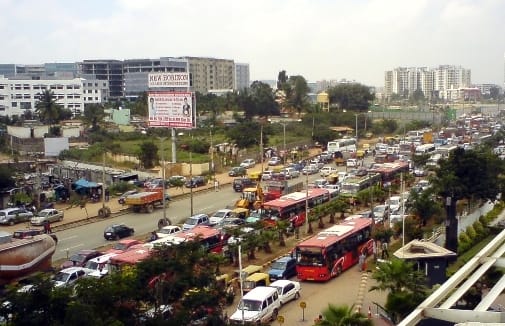Ever-increasing traffic adds to pollution and emission. File pic.
It is difficult to choose between a hot dry summer day and the day after a nice shower in Bengaluru, when it comes to the concentration of pollutants in the air. On a hot day, the air currents disperse the pollutants high up into the atmosphere, while on a day after the showers, because of the increase in humidity levels the fumes from vehicle exhaust pipes remain closer to ground level.
In Bangalore, several environmental issues have attained the status of omnipresent and instead of figuring out a solution to mitigate them, we have all internalised the problem and have learnt to live with them. Air pollution is one such critical issue that affects the environment as a whole and hence plants, animals and humans alike. And like the water-related issues, it falls between the cracks of the administration with no single department having the mandate to mitigate the issue.
The fact that the city’s traffic police underwent blood tests to detect levels of lead in their blood, or that we will soon be paying more for cleaner fuel, is an indication that all is not well with what we are spewing out of our vehicles.
Try this experiment at home!
Presence of impressionable youngsters recommended.
1. Keep a deep trough / bucket, a cup and few blocks of ice ready before the experiment (freeze water in a steel glasses or plastic bowls)
2. Place the trough on a table / floor
3. Fill about 3/4th of a tray with water and add some ice cubes, mark the level
4. Sprinkle or pour a glass of water, mark the water level increase
5. Place one block of ice in the tray, note increase and once again mark the level
6. This is the fun part: In one quick motion, drop another block of ice into the water and dunk the whole chunk into the tray and note what happens. The quantity of water displaced by the ice was unpredictable and so was the spread outside the tray, it depended on the size of the ice chunk and pressure on in when it dropped.
Air pollution causes global warming
It is an easy guess that we were talking about a tiny demo of what happens naturally when rivers empty itself into the ocean and what is bound to happen when the ice that is above sea level eventually melts or ice shelves break away due to global warming.
There is an ongoing increase in the sea level, but it is gradual. Because of the vastness of our oceans, which is 68% of the earth’s surface area, we barely realise it (except when our climate changes drastically or we wonder where the monsoons are because it is the end of June) but once at its tipping point, when ice caps melt and ice shelves break away, the quantity of water that will spill over / be displaced inlands and submerge islands is unpredictable.
The primary cause for global warming is increasing levels of carbon dioxide in the atmosphere and in cities, air pollution contributes most to increasing temperatures and sea level rise. Awareness that one’s actions have far-reaching consequences is the need of the hour and aptly, the theme for this World Environment Day was Raise Your Voice Not The Sea Level.
How to tackle air pollution?
There is no one solution to tackle the problem – there are different aspects to air pollution that influence city and its citizens and the onus lies on both, the citizens and policy makers. Some aspects that are obvious are:
-
Health and environmental impacts – a reason good enough for one to sit back and take notice
-
Role and responsibilities of various government departments and the need for them to work together – (you cannot widen roads by cutting down avenue trees to make way for more motorised vehicles and expect air pollution levels to be within safe limits or increase public transport fares and expect more commuters) and role of city planning and traffic planning in mitigating air pollution
-
Current vehicular status and air pollution levels in Bangalore and vital role of public transport and commuter cyclists
Citizen Matters will look at these aspects with respect to Air Pollution in Bangalore in the forthcoming weeks. Readers are welcome to share thoughts and experiences on the subjects written / to be addressed (thoughts that refrain from finger pointing would be appreciated)
